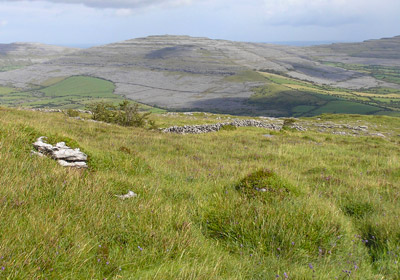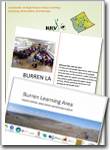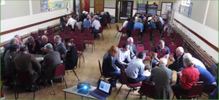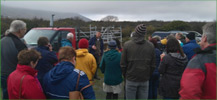The Burren, Ireland

The Burren landscape
The Burren, Ireland, encompasses Natura 2000 site and a National Park, whose grazing management is undertaken by local farmers. It is largely karst limestone landscape dominated by calcareous grassland and heaths with associated areas of limestone pavement and Atlantic Hazel woodland.
Farming systems are dominated by extensive cattle rearing.
The key issue is polarization of agricultural activities into more intensive practices, on one hand, and abandonment on extensive grasslands and heaths, on the other. The ageing farm population and change to part-time farming threaten labor intensive traditional practices. The area has been a learning ground for several innovations: design and implementation of results-based agri-environment scheme, links with local landscape and education trust, development of the learning landscape concept (curious kids, landscape learners and heritage helpers programmes, Burren Winterage Weekend). Marketing opportunities have been investigated.
Award winning EU LIFE project Burren LIFE took place here.
For more information on the HNV farming systems, challenges and innovations, see the innovations page of The Burren.
More info: www.burrenbeo.com/burren and burrenlife.com
Contact person:
Participatory approach
The Burren Learning Area (LA) team is led by James Moran of the Institute of Technology Sligo (IT Sligo), in the northwest of Ireland. The project draws on the long-standing collaboration that has been built with the key stakeholders in the area: Burrenbeo Trust (LA Lead Partner), The Burren Programme, and the Burren Irish Farmers Association.
The team is adopting a participatory approach to project implementation where stakeholders are directly involved in gathering information and sharing knowledge. A range of methods are used, including informal bilateral meetings, group discussions at farmer training events, and workshops. The participatory process was made easier in the Burren by the fact that the Burren programme or its predecessor BurrenLIFE have been in operation since 2004, and a participatory, farmer-centred approach was central to their success. During this time, members of the HNV-Link team have been working in the area and establishing relationships and building up trust between a diverse group of stakeholders. These relationships have been built up over many years and provide a sound basis for the participatory approach adopted by the HNV-Link team.
Starting from the project application stage, the HNV-Link team consulted with key stakeholders on the design of the HNV-Link project. During project development and initiation, the team also held discussions with a broad range of actors including: Teagasc (national farm advisory service), nature conservation authorities and local higher education institutions. The role of Burrenbeo Trust is particularly instrumental since it is a well-respected non-governmental organisation in the Burren dedicated to connecting people and place bringing together a wide range of stakeholders who care for the Burren.
To date, the team has focused its efforts on the co-creation of an HNV Vision for the Burren. For this, the team engaged with stakeholders for gathering existing baseline information and developing a business as usual scenario. Combining this data with the HNV innovation assessment facilitated the identification of innovation gaps. Solutions to the identified innovation gaps are needed for The Burren to realise the agreed HNV vision for the area.
The Burren Winterage Festival is an annual event in the Burren that celebrates HNV farming. Part of this festival involves the Burren Winterage School, which brings together a diverse range of stakeholders to share knowledge and ideas on sustainable farming with a particular focus on HNV farmland. The HNV-Link project has used this event as an opportunity to enable wider engagement with stakeholders and also as a place to host workshops focused on HNV-Link activities. This engagement facilitated the participation of a wide range of national and international stakeholders in the HNV-Link knowledge co-construction and sharing process. The project built on initial contacts at this event and subsequently set up bilateral meetings, the innovation seminar, and further discussion on the project at farmer training events as part of the Burren Programme.
Table 1 List of key HNV-Link activities (up to April 2018) which together detail the participatory approach adopted in the Burren
| Activities | Number of participants | Date |
|---|---|---|
| Burren Winterage School | 110 | Oct 2016 |
| Burren farmer training (including HNV-Link introduction and questionnaire) | 180 | Oct 2016 |
| Interviews with key stakeholder representatives | 5 | Jan-Mar 2017 |
| Burren learning landscape symposium with HNV-Link input | 45 | March 2017 |
| Burren Innovation Seminar | 60 | July 2017 |
| Burren Winterage School and HNVF Innovation Fair | 200 | Oct 2017 |
| Burren farmer training (including HNV-Link info update) | 250 | Nov 2017 |
Gallery
Video
Disclaimer: This document reflects the author's view and the Research Executive Agency is not responsible for any use that may be made of the information it contains.
Outputs
-
 Ireland, Burren LA
Ireland, Burren LA
- Baseline Assessment
- Report from the Innovation seminar
- Innovation report
- Participatory approach, The Burren, Ireland
- The Burren, Ireland, HNV-Link Final Conference (Poster)
- Action Plan
(April, 2019)The compilations of the respective reports from all project learning areas - Baseline Assessments, Reports from innovation seminars, and Compendium of Innovation - can be found in 'Outputs'. Reports from the Innovation seminars are in the national languages, all other materials are in English.




